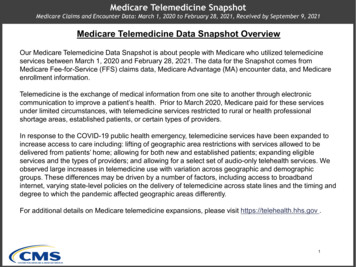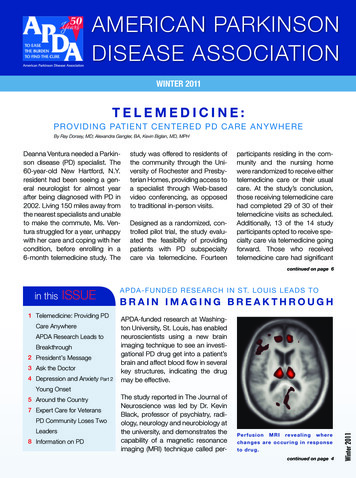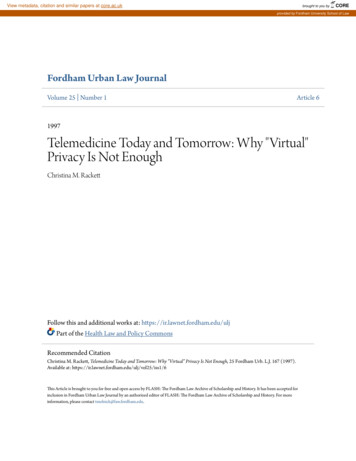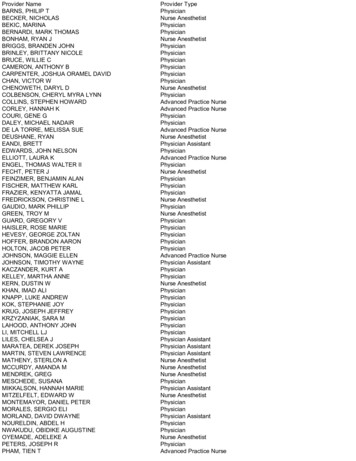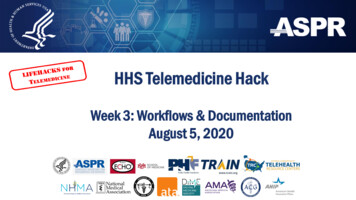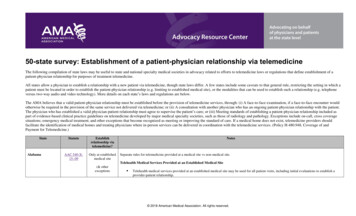
Transcription
50-state survey: Establishment of a patient-physician relationship via telemedicineThe following compilation of state laws may be useful to state and national specialty medical societies in advocacy related to efforts to telemedicine laws or regulations that define establishment of apatient-physician relationship for purposes of treatment telemedicine.All states allow a physician to establish a relationship with a new patient via telemedicine, though state laws differ. A few states include some caveats to that general rule, restricting the setting in which apatient must be located in order to establish the patient-physician relationship (e.g. limiting to established medical site), or the modalities that can be used to establish such a relationship (e.g. telephoneversus two-way audio and video technology). More details on each state’s laws and regulations are below.The AMA believes that a valid patient-physician relationship must be established before the provision of telemedicine services, through: (i) A face-to-face examination, if a face-to-face encounter wouldotherwise be required in the provision of the same service not delivered via telemedicine; or (ii) A consultation with another physician who has an ongoing patient-physician relationship with the patient.The physician who has established a valid physician-patient relationship must agree to supervise the patient’s care; or (iii) Meeting standards of establishing a patient-physician relationship included aspart of evidence-based clinical practice guidelines on telemedicine developed by major medical specialty societies, such as those of radiology and pathology. Exceptions include on-call, cross coveragesituations; emergency medical treatment; and other exceptions that become recognized as meeting or improving the standard of care. If a medical home does not exist, telemedicine providers shouldfacilitate the identification of medical homes and treating physicians where in-person services can be delivered in coordination with the telemedicine services. (Policy H-480.948, Coverage of andPayment for ship viatelemedicine?AAC 540-X15-.09Only at establishedmedical siteNotesSeparate rules for telemedicine provided at a medical site vs non-medical site.Telehealth Medical Services Provided at an Established Medical Site(& otherexceptions Telehealth medical services provided at an established medical site may be used for all patient visits, including initial evaluations to establish aprovider-patient relationship. 2018 American Medical Association. All rights reserved.
StateStatuteEstablishrelationship viatelemedicine?including mentalhealth, referral)Notes For new conditions, a patient site presenter must be available on site at the established medical site to assist with the provision of care.The distant site provider has discretion to determine if a patient site presenter is necessary for follow-up evaluation or treatment of a previouslydiagnosed condition.If the only services provided are related to mental health, a patient site presenter is not required except in cases where the patient may be a dangerto himself/herself or others.Telehealth Medical Services Provided at a Site Other than an Established Medical SiteAAC 540-X15-.10 AAC 540-X15-.11A distant site provider who provides telehealth medical services at a site other than an established medical site for a patient’s previously diagnosedcondition must either: See the patient one time in a face-to-face visit before providing telehealth medical care; or See the patient without an initial face-to-face visit, provided the patient has received an in-person evaluation by another provider who hasreferred the patient for additional care, and the referral is documented in the medical record.A patient site presenter is not required for a pre-existing condition previously diagnosed by a provider through a face-to-face visit.If the only services provided are related to mental health, a patient site presenter is not required except in cases where the patient may be a dangerto himself/herself or others.Each patient must be seen for an in-person evaluation at least once a year.Telehealth medical services may not be used to treat non-malignant pain with scheduled drugs, with the exception of patients who are enrolled in aqualified multidisciplinary hospice or a palliative care program.A distant site provider may treat an established patient’s new symptoms which are unrelated to the patient’s pre-existing condition, provided that thepatient is advised to see a provider in a face-to-face visit within 72 hours. A distant site provider may not provide continuing telehealth medicalservices for these new symptoms to a patient who is not seen by a provider in a face-to-face visit within 72 hours.Evaluation of the patientA distant site provider who utilizes telehealth medical services must ensure that a provider-patient relationship is established. At a minimum, this includesthe following: Establishing that the person requesting the treatment is in fact the person he/she claims to beEstablishing a diagnosis through the use of acceptable medical practices, including patient history, an appropriate physical examination, andindicated diagnostic studies 2018 American Medical Association. All rights reserved.2
StateStatuteEstablishrelationship viatelemedicine?Notes Discussing with the patient the diagnosis, the evidence for it, and the risks and benefits of various treatment options; andEnsuring the availability of appropriate coverage of the patient for follow-up care.An online or telephonic evaluation solely by questionnaire does not constitute an acceptable standard of care.DefinitionsEstablished medical site: A location where a patient can receive care, where there is a patient site presenter and sufficient technology to allow for anadequate examination (not the patient’s home, except in case of emergency).Face-to-face visit: Patient and provider are at the same physical location OR where a patient is located at an established medical site.In-person evaluation: Patient and provider are at the same physical location.AlaskaAS 08.64.01(6)AS 08.64.364YesThe medical board shall adopt regulations that establish guidelines for a physician who is rendering a diagnosis, providing treatment, or prescribing,dispensing, or administering a prescription drug to a person without conducting a physical examination under AS 08.64.364; the guidelines must include anationally recognized model policy for standards of care of a patient who is at a different location than the physician.(a) The medical board cannot impose disciplinary sanctions for rendering a diagnosis, providing treatment, or prescribing, dispensing, or administering aprescription drug that is not a controlled substance to a person without conducting a physical examination if: (1) The physician is located within the stateand a physician or provider is available for follow up care; or (2) The physician requests that the person consent to sending a copy of all records of theencounter to the person's primary care provider if the prescribing physician is not the person's primary care provider, and, if the patient consents, thephysician sends the records to the person's primary care provider.(c) The board may not impose disciplinary sanctions on a physician for prescribing, dispensing, or administering a prescription drug that is a controlledsubstance or botulinum toxin if the requirements under (a) of this section are met and the physician prescribes, dispenses, or administers the controlledsubstance or botulinum toxin when an appropriate licensed health care provider is present with the patient to assist the physician with examination,diagnosis, and treatment. 2018 American Medical Association. All rights reserved.3
StateStatuteEstablishrelationship viatelemedicine?Notes(d) Notwithstanding (a) and (c) of this section, a physician may not (1) prescribe, dispense, or administer an abortion-inducing drug under (a) of this sectionunless the physician complies with AS 18.16.010; or (2) prescribe, dispense, or administer a prescription drug in response to an Internet questionnaire orelectronic mail message to a person with whom the physician does not have a prior physician-patient relationship.12 AAC40.967(27)Unprofessional conductProviding treatment, rendering a diagnosis, or prescribing medications based solely on a patient-supplied history that a physician licensed in this statereceived by telephone, facsimile, or electronic format.ArizonaARS32.1401(27)(ss)and (ww), ARS32-1854(48)Yes27. “Unprofessional conduct” includes the following, whether occurring in this state or elsewhere: (ss) Prescribing, dispensing or furnishing a prescriptionmedication or a prescription-only device as defined in section 32-1901 to a person unless the licensee first conducts a physical or mental health statusexamination of that person or has previously established a doctor-patient relationship. The physical or mental health status examination may be conductedduring a real-time telemedicine encounter with audio and video capability if the telemedicine audio and video capability meets the elements required by theCenters for Medicare and Medicaid Services, unless the examination is for the purpose of obtaining a written certification from the physician for thepurposes of title 36, chapter 28.1. This subdivision does not apply to:(i) A physician who provides temporary patient supervision on behalf of the patient's regular treating licensed health care professional or provides aconsultation requested by the patient's regular treating licensed health care professional.(ii) Emergency medical situations as defined in section 41-1831.(iii) Prescriptions written to prepare a patient for a medical examination.(iv) Prescriptions written or prescription medications issued for use by a county or tribal public health department for immunization programs or emergencytreatment or in response to an infectious disease investigation, public health emergency, infectious disease outbreak or act of bioterrorism. For the purposesof this item, "bioterrorism" has the same meaning prescribed in section 36-781.(v) Prescriptions written or antimicrobials dispensed to a contact as defined in section 36-661 who is believed to have had significant exposure risk asdefined in section 36-661 with another person who has been diagnosed with a communicable disease as defined in section 36-661 by the prescribing ordispensing physician.(vi) Prescriptions written or prescription medications issued for administration of immunizations or vaccines listed in the United States centers for diseasecontrol and prevention's recommended immunization schedule to a household member of a patient.(vii) Prescriptions for epinephrine auto-injectors written or dispensed for a school district or charter school to be stocked for emergency use pursuant tosection 15-157 or for an authorized entity to be stocked pursuant to section 36-2226.01.(viii) Prescriptions written by a licensee through a telemedicine program that is covered by the policies and procedures adopted by the administrator of ahospital or outpatient treatment center. 2018 American Medical Association. All rights reserved.4
StateStatuteEstablishrelationship viatelemedicine?Notes(ix) Prescriptions for naloxone hydrochloride or any other opioid antagonist approved by the United States food and drug administration that are written ordispensed for use pursuant to section 36-2228 or 36-2266.AMBSubstantivePolicyStatement 12Rules on internet prescribingThe medical board’s rules on internet prescribing provide that prior to providing treatment, including issuing prescriptions, electronically or otherwise, aphysician must document a patient evaluation, including taking a history and conducting a physical examination adequate to establish the diagnoses andidentify underlying conditions and/or contraindications to the treatment recommended or provided. There are exceptions to this requirement for coveringphysicians, emergencies, prescriptions written to prepare a patient for an examination and prescribing or dispensing for immunization programs.DefinitionsTelemedicine – The practice of health care delivery, diagnosis, consultation and treatment and the transfer of medical data through interactive audio, videoor data communications that occur in the physical presence of the patient (including audio or video communications sent to a provider for diagnostic ortreatment consultation).MiscellaneousThe Arizona Board of Osteopathic Examiners’ telemedicine policy (ARS 36-3602) does not address formation of the patient-physician relationship.In addition to the requirements of the standard of care, ARS 2-1401(27)(ss), makes it an act of unprofessional conduct for a physician to prescribe, dispenseor furnish a prescription medication or prescription-only device to a person unless the physician first conducts a physical examination of that person or haspreviously established a physician-patient relationship. How the examination is conducted will depend on the patient and condition being treated. Whatconstitutes an adequate work-up depends on the facts of the specific situation; however, an on-line questionnaire cannot meet these minimum requirements.ArkansasACA 17-80403ACA 17-80117YesA patient completing a medical history online and forwarding it to a physician is not sufficient to establish the relationship, nordoes it qualify as store-and-forward technology. 2018 American Medical Association. All rights reserved.5
StateStatuteAR Code 1792-1003Establishrelationship viatelemedicine?NotesA physician may not use telemedicine to issue a prescription for a controlled substance under schedules II through V unless theyhave seen the patient in-person or a relationship exists through consultation or referral; on-call or cross coverage situations; orthrough an ongoing personal or professional relationshipWithout a prior and proper patient-provider relationship, providers are prohibited from issuing prescriptions solely in response to an Internetquestionnaire, an Internet consult, or a telephone consult.Establishment of professional relationship(a)(1) A healthcare professional at a distant site shall not utilize telemedicine with respect to a patient located in Arkansas unless a professional relationshipexists between the healthcare professional and the patient or the healthcare professional otherwise meets the requirements of a professional relationship asdefined in §17-80-402.[17-80-402 states: At minimum, a relationship established between a healthcare professional and a patient when:(i) The healthcare professional has previously conducted an in-person examination and is available to provide appropriate followup care, when necessary, at medically necessary intervals;(ii) The healthcare professional personally knows the patient and the patient's relevant health status through an ongoing personalor professional relationship and is available to provide appropriate follow-up care, when necessary, at medically necessaryintervals;(iii) The treatment is provided by a healthcare professional in consultation with, or upon referral by, another healthcareprofessional who has an ongoing relationship with the patient and who has agreed to supervise the patient's treatment, includingfollow-up care;(iv) An on-call or cross-coverage arrangement exists with the patient's regular treating healthcare professional or anotherhealthcare professional who has established a professional relationship with the patient;(v) A relationship exists in other circumstances as defined by rule of the Arkansas State Medical Board for healthcareprofessionals under its jurisdiction and their patients; or(vi) A relationship exists in other circumstances as defined by rule of a licensing or certification board for other healthcareprofessionals under the jurisdiction of the appropriate board and their patients if the rules are no less restrictive than the rules ofthe Arkansas State Medical Board;] 2018 American Medical Association. All rights reserved.6
StateStatuteACA 17-80404Establishrelationship viatelemedicine?Notes(2) The existence of a professional relationship is not required in the following circumstances:(A) Emergency situations where the life or health of the patient is in danger or imminent danger; or(B) Simply providing information of a generic nature, not meant to be specific to an individual patient.(b) If the establishment of the professional relationship is permitted via telemedicine under § 17-80-402(4)(A)(v) or § 17-80-402(4)(A)(vi), telemedicinemay be used to establish the professional relationship only for situations in which the standard of care does not require an in-person encounter.(c) “Professional relationship” does not include a relationship between a healthcare professional and a patient established only by the following:(1) An internet questionnaire;(2) An email message;(3) Patient-generated medical history;(4) Audio-only communication, including without limitation interactive audio;(5) Text messaging;(6) A facsimile machine; or(7) Any combination thereof;Professional relationship – At minimum, a relationship established between a healthcare professional and a patient when:(i) The healthcare professional has previously conducted an in-person examination and is available to provide appropriate follow-up care, when necessary, atmedically necessary intervals;(ii) The healthcare professional personally knows the patient and the patient's relevant health status through an ongoing personal or professional relationshipand is available to provide appropriate follow-up care, when necessary, at medically necessary intervals;(iii) The treatment is provided by a healthcare professional in consultation with, or upon referral by, another healthcare professional who has an ongoingrelationship with the patient and who has agreed to supervise the patient's treatment, including follow-up care;(iv) An on-call or cross-coverage arrangement exists with the patient's regular treating healthcare professional or another healthcare professional who hasestablished a professional relationship with the patient;(v) A relationship exists in other circumstances as defined by rule of the Arkansas State Medical Board for healthcare professionals under its jurisdiction andtheir patients; or(vi) A relationship exists in other circumstances as defined by rule of a licensing or certification board for other healthcare professionals under thejurisdiction of the appropriate board and their patients if the rules are no less restrictive than the rules of the Arkansas State Medical Board; 2018 American Medical Association. All rights reserved.7
StateStatuteEstablishrelationship viatelemedicine?NotesRemote patient monitoring – The use of synchronous or asynchronous electronic information and communication technology to collect personal healthinformation and medical data from a patient at an originating site that is transmitted to a healthcare professional at a distant site for use in the treatment andmanagement of medical conditions that require frequent monitoring;ACA 17-80405Store-and-forward technology – The asynchronous transmission of a patient's medical information from a healthcare professional at an originating site to ahealthcare professional at a distant site; andTelemedicine – The use of electronic information and communication technology to deliver healthcare services, including without limitation the assessment,diagnosis, consultation, treatment, education, care management, and self-management of a patient. “Telemedicine” includes store-and-forward technologyand remote patient monitoring.ACA 17-80406ACA 17-80407Act 887 requires a pre-existing physician-patient relationship before a telemedicine encounter. The relationship may be established via an in-person exam,personally knowing the patient and their health status, in consultation with a referral by another health care provider who has a relationship with the patientor through an on-call or cross coverage arrangement with the patient’s regular treating provider.ACA 17-80401CaliforniaCal. Bus. &Prof. Code §2290.5Cal. Bus. &Prof. Code §2242.1(a)YesProviders are prohibited from prescribing or dispensing dangerous drugs or dangerous devices on the Internet without an appropriate priorexamination and medicalindication.Remote dispensing site pharmacies are permitted to dispense or provide pharmaceutical care services in medically underserved areas. Asupervising pharmacy must provide telepharmacy services to the remote dispensing site pharmacy and shall not be located greater than 150road miles from the remote dispensing site pharmacy.Cal. Bus. &Prof. Code §4130-4135 2018 American Medical Association. All rights reserved.8
StateColoradoStatuteEstablishrelationship viatelemedicine?CMB policy40-3YesCMB policy40-27NotesPolicy Statement Regarding the Provider-Patient RelationshipThe “Provider-Patient Relationship” as the mutual understanding, between a provider and patient, of the shared responsibility for the patient’s healthcare.The provider-patient relationship is established when: The provider agrees to undertake diagnosis and treatment of the patient, and the patient, or a medical proxy for the patient, agrees to be treatedwhether or not there has been an in-person encounter between the patient and the provider; and The provider: Verifies and authenticates the patient’s identity; Discloses his or her identity and applicable credential(s) to the patient; and Obtains appropriate informed consent after any relevant disclosures regarding the delivery models and treatment methods or limitations,including any special informed consents regarding the use of telehealth technologies.Guidelines for the Appropriate Use of Telehealth Technologies in the Practice of MedicineWhere an existing provider-patient relationship is not present, a provider must take appropriate steps to establish a provider-patient relationship consistentwith the guidelines identified in Board Policy 40-3. Provider-patient relationships may be established using telehealth technologies so long as therelationship is established in conformance with generally accepted standards of practice.MiscellaneousLaw passed in 2015 states that Colorado will not require in-person contact between a patient and provider in order for covered services to be reimbursed.The state’s workers compensation statute allows establishment of a patient-physician relationship through two way live audio/video servicesAn “appropriate personal physical examination” as required by this regulation to establish a bona fide physician-patient relationship for purposes ofprescribing medical marijuana may not be performed by remote means, including telemedicine.Definitions 2018 American Medical Association. All rights reserved.9
StateStatuteEstablishrelationship viatelemedicine?NotesTelehealth – A mode of delivery of healthcare services through telecommunications systems, including information, electronic, and communicationtechnologies, to facilitate the assessment, diagnosis, consultation, treatment, education, care management, or self-management of a covered person’s healthcare while the covered person is located at an originating site and the provider is located at a distant site. The term includes synchronous interactions andstore-and-forward transfers. Telehealth does not include the delivery of health care services via telephone, facsimile machine or electronic mail.Practice of medicine includes the delivery of telemedicine. It is within professional’s scope of practice to use advanced technology including, but not limitedto, interactive audio, interactive video, or interactive data communication.ConnecticutPublic Act 1588 (2015)Yes(Not prohibited)(b) (1) A telehealth provider shall only provide telehealth services to a patient when the telehealth provider: (A) Is communicating through real-time,interactive, two-way communication technology or store and forward technologies; (B) has access to, or knowledge of, the patient's medical history, asprovided by the patient, and the patient's health record, including the name and address of the patient's primary care provider, if any; (C) conforms to thestandard of care applicable to the telehealth provider's profession and expected for in-person care as appropriate to the patient's age and presenting condition,except when the standard of care requires the use of diagnostic testing and performance of a physical examination, such testing or examination may becarried out through the use of peripheral devices appropriate to the patient's condition; and (D) provides the patient with the telehealth's provider licensenumber and contact information.(2) At the time of the telehealth provider's first telehealth interaction with a patient, the telehealth provider shall inform the patient concerning the treatmentmethods and limitations of treatment using a telehealth platform and, after providing the patient with such information, obtain the patient's consent toprovide telehealth services. The telehealth provider shall document such notice and consent in the patient's health record. If a patient later revokes suchconsent, the telehealth provider shall document the revocation in the patient's health record.(c) Notwithstanding the provisions of this section or title 20, no telehealth provider shall prescribe any schedule I, II or III controlled substance through theuse of telehealth, except a schedule II or III controlled substance other than an opioid drug, as defined in section 20-14o, in a manner fully consistent withthe Ryan Haight Online Pharmacy Consumer Protection Act, 21 USC 829(e), as amended from time to time, for the treatment of a person with a psychiatricdisability or substance use disorder, as defined in section 17a-458, including, but not limited to, medication-assisted treatment. A telehealth provider usingtelehealth to prescribe a schedule II or III controlled substance pursuant to this subsection shall electronically submit the prescription pursuant to section21a-249, as amended by this act.(d) Each telehealth provider shall, at the time of the initial telehealth interaction, ask the patient whether the patient consents to the telehealth provider'sdisclosure of records concerning the telehealth interaction to the patient's primary care provider. If the patient consents to such disclosure, the telehealth 2018 American Medical Association. All rights reserved.10
StateStatuteEstablishrelationship viatelemedicine?Notesprovider shall provide records of all telehealth interactions to the patient's primary care provider, in a timely manner, in accordance with the provisions ofsections 20-7b to 20-7e, inclusive.(e) Any consent required under this section shall be obtained from the patient, or the patient's legal guardian, conservator or other authorized representative,as applicable.(f) The provision of telehealth services and health records maintained and disclosed as part of a telehealth interaction shall comply with the provisions of theHealth Insurance Portability and Accountability Act of 1996 P.L. 104-191, as amended from time to time.(g) Nothing in this section shall prohibit: (1) A health care provider from providing on-call coverage pursuant to an agreement with another health careprovider or such health care provider's professional entity or employer; (2) a health care provider from consulting with another health care providerconcerning a patient's care; (3) orders of health care providers for hospital outpatients or inpatients; or (4) the use of telehealth for a hospital inpatient,including for the purpose of ordering any medication or treatment for such patient in accordance with Ryan Haight Online Pharmacy Consumer ProtectionAct, 21 USC 829(e), as amended from time to time. For purposes of this subsection, "health care provider" means a person or entity licensed or certifiedpursuant to chapter 370, 372, 373, 375, 376 to 376b, inclusive, 378, 379, 380, 381a, 383 to 383c, inclusive, 384b, 397a, 399 or 400j, or licensed or certifiedpursuant to chapter 368d or 384d.(h) No telehealth provider shall charge a facility fee for telehealth services.DefinitionsTelehealth – The mode of delivering health care or other health services via information and communication technologies to facilitate the diagnosis,consultation and treatment, education, care management and self-management of a patient's physical and mental health, and includes (A) interactionbetween the patient at the originating site and the telehealth provider at a distant site, and (B) synchronous interactions, asynchronous store and forwardtransfers or remote patient monitoring. Telehealth does not include the use of facsimile, audio-only telephone, texting or electronic mail.Delaware24 Del. Code1769DYes(a) Physicians may practice Telemedicine and Telehealth. Provided that Telemedicine shall not be utilized by a physician with respect to any patient in theabsence of a physician-patient relationship, except for the instances in subsection (i). 2018 American Medical Association. All rights reserved.11
StateStatuteDE Code, Title16 S4744Establishrelationship viatelemedicine?Notes(b) Physicians who utilize telemedicine shall, if such action would otherwise be required in the provision of the same service not delivered via telemedicine,ensure that a proper physician-patient relationship is established either in-person or through telehealth which includes but is not limited to:(1) fully verifying and authenticating the location and, to the extent possible, identifying the requesting patient;(2) disclosing and validating the provider’s identity and applicable credential(s);(3) obtaining appropriate consents from requesting patients after disclosures regarding the delivery models and treatment met
A distant site provider may not provide continuing telehealth medical services for these new symptoms to a patient who is not seen by a provider in a face-to-face visit within 72 hours. Evaluation of the patient A distant site provider who utilizes telehealth medical services must ensure that a provider-patient relationship is established.
